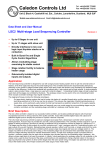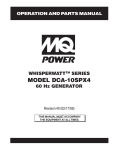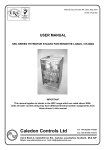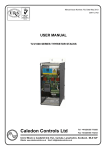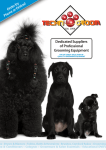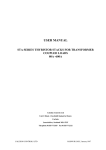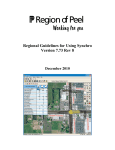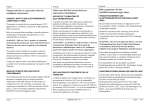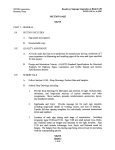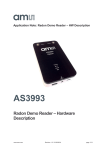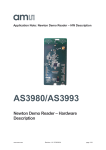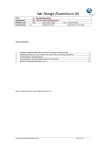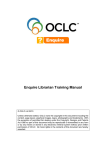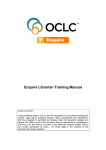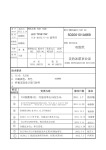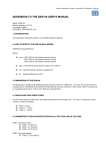Download Word Pro - cu10L1r7stagingpdf.lwp
Transcript
Caledon Controls Ltd Tel +44 (0)1555 773355 Fax +44 (0)1555 772212 Unit 2 Block 4, Castlehill Ind. Est., Carluke, Lanarkshire, Scotland, ML8 5UF Website www.caledoncontrols.co.uk Email [email protected] Data Sheet and User Manual CU02: Staging Controller for Load Sequencing Control Up to 6 Stages in one unit Up to 16 stages with slave units* Directly interfaces to low cost logic input thyristors or to contactors Built in Burst fire or Single Cycle Control Algorithms Separate analogue output may be used with phase angle thyristors Allows modulating stage oversizing for stable control Stage rotation facility to balance heater usage *Check availability Application The staging controller is designed for use with a large process heating system which is split into several banks of heaters, all of which apply heat input to the same heating load. The staging controller balances the required heating demand by switching on the number of stages (heater banks) which most nearly match the demand, and modulating one additional stage to make up the difference. Versions are available with combined relay + logic outputs and all logic outputs. A single analogue output is also provided. Relay + logic types are used with contactor stages + 1 modulating thyristor stage; all logic outputs are used when all the stages are controlled by thyristors. The analogue output may be used to drive one modulating thyristor which accepts a standard analogue input signal if preferred. The staging technique provides the following advantages:1 On large electric heating systems the load is broken into banks of a smaller kilowatt rating, and the maximum size of load being switched on or off at any one time is reduced. This reduces the magnitude of switching disturbances on supply lines, and is particularly useful where the load represents a significant proportion of the supply capacity. 2 On systems where the load demand does not frequently vary over a wide range the non-modulating stages may be contactor controlled, and the modulating stage thyristor controlled. Brief Description The Caledon staging controller accepts an analogue input signal from a temperature controller which represents heating demand. A second input is provided for use with a manual potentiometer. The controller provides outputs for 6 stages of heating and there is provision for future slaving of additional units to increase the number of stages to a maximum of 16. The stages may be either 5 relay outputs for use with contactors and 1 logic / analogue output for a modulating thyristor, or 6 logic outputs for use with thyristors. Modulating logic outputs operate in either burst fire mode, or single cycle burst fire mode. Both are intended for use with thyristor controllers which accept a logic input signal and have zero voltage switch on. The stages may either be of the same power rating, or the modulating stage may be oversized which potentially reduces the amount of stage switching required to maintain temperature control . A single 0-5V analogue output is provided which may be used with an analogue input thyristor stack for the modulating stage if preferred - this allows a phase angle stack to be used for example. In the case of logic input thyristor only systems in which all the stages have the same power rating, the stages may optionally be rotated around the heater banks, which helps to balance the total usage of each heater bank. Specifications Supply voltage Power consumption Ambient temperature Approximate Dimensions Input signal 115V or 230V AC 50 / 60 Hz +10% -15% 4VA 0-50OC 104mm high x 155mm wide x 80mm deep (Symmetrical DIN rail mounted) 0-5V, 0-10V, 1-5V, 2-10V, 0-20mA, 4-20mA, link selectable Auxiliary input signal Output signal 0-5V (manual input) may be fed by a 10kΩ potentiometer powered from the unit Non modulating stages: relay or logic signal (specified at time of ordering) Modulating stage: Logic signal for use with zero voltage switch on thyristors, 1 off analogue signal (0-5V). Relay contacts rated 250V AC, 2A Contact closure or npn pull down switches unit to manual operation LED indicators for power, manual operation selected, outputs on Complies with European Low Voltage Directive and major international standards Pollution degree 2, Overvoltage category 3, IEC 664 Complies with European EMC Directive for operation in an industrial environment Digital input signal Indicators Safety Standards EMC Standards Preset Potentiometers P1 Stage switching time delay P2 Ramp time In setup mode sets modulating stage oversize P3 Burst fire cycle time 0.25s to 1 minute (prevents rapid cycling of stages) 5-50s (see section on Ramp Function) 0-100% 0.3s to 20s at 50% duty cycle Jumper and DIP Switch Options Settings Jumpers - Analogue Input Selection Off On JMP1 A 0-5V 0-10V JMP1 B Voltage Input Current Input (connects a 250Ω resistor across the input). Set Jmp 1A off. For signals with offset (1-5V, 2-10V, 4-20mA) set switch 1:7 on. DIP Switch 1 1:1 Function Notes Off Single cycle operation On Standard burst fire operation Select the control mode for the modulating stage logic output. Switches 1:2 to 1:4 must be set correctly for the modulating logic output to operate correctly in single cycle mode. The controller power supply must also be wired correctly to match the setting on switch 1:2. The switches must also be set correctly for the logic output to operate correctly in burst fire mode, unless switch 1:6 is on, in which case the setting of these switches, and the power supply connection is immaterial If the analogue output is used for the modulating stage the setting of these switches, and the power supply connection is immaterial. 1:2: 1:3 1:4 1:5 1:6 1:7 1:8 Off Controller power supply in phase with line to line supply Normal operation On Controller power supply in phase with line to neutral Cannot be used with 2-line control. Off Load connection for 2-line control. Load star or delta connected. Only 2 of the 3 lines are controlled. The third is directly connected. On Load connection for 3 line control All 3 lines are controlled by thyristors. Off 3-line control, 3-wire load connection (star or delta). On 3-line control, 4-wire star load connection Only operative if 1:3 is on. Must then match the load connection. Off In auto mode the front panel potentiometer has no function On In auto mode the front panel potentiometer sets an upper limit on the input control signal Off No function On Modulating logic output signal not synchronised to the mains frequency Off Analogue inputs without offset (0-5V etc) On Analogue inputs with offset (1-5V etc) Off Normal operating mode On Setup mode In manual mode the potentiometer controls the output power independent of the input control signal. Applies to software versions CU07E5Rx (where x is the issue number). Standard from 2005. Software version CU07E1Rx available on request offers proportioning of the input signal by the front panel potentiometer when in manual mode. Normally should be off. See switch 1:2 above and section on Controller supply and synchronisation In set up mode potentiometer P2 may be used to set the oversize of the modulating stage. See section on Oversizing the modulating stage. Page 2 DIP Switch 2 Switches 1 to 4 set the number of stages in addition to the modulating stage. For a single unit (without slaves) 5 is the maximum valid number. Switch Setting 1 LSB 0 1 0 1 0 1 0 1 0 1 0 1 0 1 0 1 2 0 0 1 1 0 0 1 1 0 0 1 1 0 0 1 1 3 0 0 0 0 1 1 1 1 0 0 0 0 1 1 1 1 4 MSB 0 0 0 0 0 0 0 0 1 1 1 1 1 1 1 1 Number of non modulating stages # 1 2 3 4 5 6 7 8 9 10 11 12 13 14 15 # When switches are set to 0000 the modulating stage output is fed to all stages, allowing simultaneous modulating of all stages without rewiring (Not suitable for use with contactors!) 5 6 7* 8* Off No function On Stages rotate. The outputs are rotated round the stages every 5 hours. see section on Stage rotation. See also appendix 1 on page 8 for different software versions Off Output ramp function off On Output ramp function on Off Stand alone unit or master On Slave Unit Off Slave Unit 1 (stages 7-11) On Slave Unit 2 (stages 12-16) When the ramp function is on the modulating output ramps in response to a step change of input. The time to ramp from 0-100% is set on P 2 Sets whether the unit is a master or a slave. A master unit may be used alone for 6 stages, or with 1 or 2 slaves for 11 or 16 stages. Slave units do not have a modulating output. The setting on this switch only takes effect if switch 2:7 is set on, and determines how the master unit treats the slave. * Initial versions of the staging controller do not support slave operation. Set switches 7 and 8 off. Terminal Function List Terminal Number Function Notes 1 Functional Earth Not a safety earth. May be connected to chassis to improve EMC noise immunity. 2 +5V Output May be used to energise a 10K potentiometer connected to the manual input. 3 Manual Input Accepts a 0-5V signal when the controller is in manual mode. It is advisable to use a screened cable for the leads to the manual potentiometer, particularly if they are longer than 1 metre, to avoid interference pick up which could cause jitter when switching between stages. The screen should be grounded adjacen to the controller, or to terminal 1 if this is grounded. 4 0V 0V common for input signals, manual potentiometer and analogue output. 5 Setpoint input Accepts the setpoint signal (power demand) from a temperature controller. Signal type determined by JMP1 setting. 6 Auto/manual select When off controller uses the main setpoint input (5). When linked to 0V (or pulled to 0V by an NPN transistor) controller uses manual input (3) 7 0V 0V common for input signals and analogue output. 8 Analogue output 0-5V signal which represents the output value of the modulating stage. 9 0V 0V common for input signals, analogue output and comms. 10 Comms For future use, to enable control of slave controllers. Do not wire to these terminals. 11 Comms 12 Auxiliary Output Not used (provides an additional logic output for special applications, selected by JMP2. 13 +12V +12V unregulated supply. Common positive for logic output signals. 14 Output 1 Logic output (-ve) pull down NPN open collector output, to drive a thyristor controller. In systems with contactors, or where the modulating control is not rotated around the heaters, this stage will be the modulating stage. Outputs 2-6 are either on or off. 15 +12V +12V unregulated supply. Common positive for logic output signals. 16 Output 2 17 Output 3 18 Output 4 These outputs are specified at the time of ordering as either logic ouputs (NPN open collector pull down), or N/O relay outputs for driving contactors. Contactor coils should be suppressed. In systems with less than 6 stages the lower numbered outputs are used; eg a 3 stage system uses outputs 1, 2 and 3. 19 Output 5 20 Output 6 21 Relay Common Common for outputs 2-6 when these are specified as relay outputs. 22 Supply Live Either 115V +10% -15%, or 230V +10% -15%, 50 or 60 Hz. Voltage is selected by jumper assembly at top right of module. 23 No connection Do not make any connection to this terminal. 24 Supply Neutral Page 3 Safety and Regulatory Considerations The controller must be wired in accordance with electrical standards applicable in the country of installation. When controlling heating loads it is important to consider the effects of loss of control due to a fault; eg the heating power being turned fully on. If this could result in a dangerous situation then independent means of monitoring the load and removing power should be fitted. This is a requirement of international standards. Control of thyristors in single cycle mode gives rise to harmonic currents and electrical noise, and it should be ascertained that these fall within acceptable limits for the application. System Configuration Options and Requirements Two versions of the controller are available, for use with thyristor only systems, and contactor / thyristor systems. Typical wiring schematics for a 3-stage system of each type are given. Contactor + Thyristor Control This is the lowest cost option, and is most suited to loads which do not va ry rapidly, or tend to stabilise at a more or less constant value for long periods. The controller is fitted with relays to operate the contactors. A single modulating thyristor stage is used (stage 1 and output 1) to exactly balance the load demand. The thyristor may be either a logic input type, driven by the stage 1 logic output on the staging controller, or an analogue input type driven by the analogue output on the controller. It is advantageous if the modulating stage is oversized relative to the contactor stages, as this will help reduce the frequency of contactor switching, and avoid the situation where the required power demand is met just at the point where one stage is switching on / off. All Thyristor Control This is a more versatile form of control. Only one of the stages is modulating (stage 1, output 1, but see Stage Rotation below), but the non modulating stages are also switched by thyristors. This is more satisfactory for loads which vary frequently, as there is not the switching life problem associated with contactors. The thyristors may all be logic input types, or alternatively the modulating stage may be an analogue input type. It is less important th an when using contactors that the modulating stage be oversized, as other stages can be switched frequently . However, better control may be obtained if the modulating stage is oversized, as there will always be time delays associated with the heating and cooling of elements etc as stages are switched in and out. Oversizing the Modulating Stage Most heater batteries are designed with all stages having the same power rating. From a control point of view there is an advantage in having the modulating stage oversized relative to the other stages. Consider the case where the relative sizes of the modulating stage and the other stages are 100 : 80. As the input signal rises from zero the modulating stage output will increase until it is fully on. At this point the second stage is switched in, and the modulating output is cut back to 20%. If t he input signal now starts to fall, the modulating stage has to fall back by 20% before the second stage is switched back off, and when this happens the modulating output is stepped up to 80%. It must then be required to increase by 20% before the second stage is switched back on. It will be seen that the oversizing creates a switching hysteresis which reduces the number of times stages switch on and off in response to the input control signal. If the stages are of equal size there is, strictly speaking, no hysteresis. In practice, in this controller a small hysteresis of 1% is introduced. In conjunction with the timed switching delay function, this results in acceptable switching frequency, but at the expense of a potential loss of control accuracy. Setting the Oversize The controller must be set up to match the oversize of the modulating stage of the heater battery if appli cable. (The default setting is no oversize). To set up the oversize, switch on DIP switch 1: 8 (Setup). The 0-5V analogue output (terminals 8 and 9) now represents modulating stage oversize 0-100%. which may be monitored on a digital volt meter . For 10 seconds after switching on the switch the value transmitted is the current saved setting , and if the switch is switched off again within the 10 seconds this value will be retained. After 10 seconds the value transmitted is read from potentiometer P2 and may be adjusted to the value required (The previous stored value is now lost). When it is set correctly, switch off DIP switch 1:8. The value is then stored in EEPROM, and the analogue output reverts to its normal function. Stage Rotation DIP switch 2:5 enables stage rotation. This rotates which output on the controller is assigned to each stage on a fixed periodic basis. (Standard period is 5 hours). The purpose is to help balance the usage of all the heater stages in the battery over time. Stage rotation can only be used, and must only be set when:1 All the heater stages are of the same power rating. 2 All the heater stages are thyristor controlled. 3 The logic outputs are used for all stages. Modulating Stage Thyristor Firing Modes The logic output offers two firing modes; burst fire and single cycle burst fire. Burst fire control is a method of controlling the load power by switching the current on and off. The current is on for a number of supply cycles and off for a number of cycles. The load power is varied by varying the ratio of on time to off time. In burst fire mode the fastest cycle time offered by this controller is 0.3s at 50% duty cycle, corresponding to approximately 8 cycles on and 8 cycles off at 50Hz. Potentiometer P3 may be used to adjust the cycle time between 0.3s and 20s. Single cycle burst fire control is the fastest type of burst fire control possible. At 50% duty cycle (power) one mains cycle on is followed by one off. Above 50% power only one mains cycle is allowed to be off before another on cycle. Any number of on cycles may follow each other consecutively. Below 50% power only one mains cycle is allowed to be on before another off Page 4 cycle. Any number of off cycles may follow each other consecutively. The average ratio of on to off cycles is controlled to obtain the required average load power. Single cycle control can be used for fast response loads, or to minimise the effect of burst fire operation on supply generator speed control. If phase angle control is preferred for the modulating stage the analogue output (0-5V) may be used to drive a suitable thyristor stack which accepts an analogue input. Controller Supply Connection, Mains Synchronisation and Typical Wiring Schemes The controller must be adjusted for the correct supply voltage; either 115V or 230V +10% -15%. The setting is adjusted by moving the jumper plug, which is on the right hand side of the unit, to the correct position. To gain access undo the 2 screws at either end of the unit, remove the cheeks and unclip the cover. 115V is set with the plug moved toward the top of the unit, and 230V with the plug moved toward the bottom of the unit, as indicated by the small lines on the PCB which should be alongside the wire links in the plug. Typical wiring schematics are given at the end of the manual for 3-stage 3-phase systems. The controller logic output for the modulating stage is synchronised to the mains frequency. This synchronisation is derived via the controller power supply. When operating with single cycle control it is essential that the power supply be correctly phase related to the supply which feeds power to the heaters. The thyristors must have zero voltage switch on. If the thyristors have 3-line control (the ones i n the typical schematics have only 2-line control) the controller power supply may be derived across two of the lines via a step-down transformer (as shown in the schematics) or connected line to neutral. DIP switch 1:2 must be set to match. If the thyristors have only 2-line control the power supply must be derived across the two lines which are controlled by the thyristor as shown in the schematics. This is to avoid the need to know the supply rotation. With this proviso the supply rotation is immaterial in all cases. DIP switches 1:3 and 1:4 must be set to match the load configuration. When operating with burst fire control, DIP switch 1:6 may be switched on, which unsynchronises the logic output from the mains cycles. The phase relationship of the controller power supply to the load power supply is then immaterial and the setting of DIP switches 1:2 to 1:4 will have little effect. It may be beneficial to use synchronous operation, particularly with fast cycle rates, as the synchronous algorithm used is designed to maintain load balance and eliminate small DC components from the load current. If the supply to the controller is phased correctly it allows the flexibility to change to single cycle operation if found desirable. If synchronous operation is chosen then the power supply connection and DIP switch settings must be adhered to as for single cycle operation. Delay between Stage Switching Each time a stage switches either on or off a timer is set, which prevents further stage switching until it times out. The timer is adjustable by potentiometer P1 between 0.25s and 1 minute. The timer prevents rapid cycling of the stages, and ensures that on initial switch on, when the input control signal to the controller may be at maximum, the load is switched on in stages in a controlled manner. It also inevitably means that the load cannot be switched off suddenly by reducing the control signal to zero, and if this is a requirement (eg in emergency) some other means must be provided for cutting the load power. The timer should not be set longer than necessary, as this may have an adverse effect on control stability. The longer the time set, the longer the integral time constant in a PID temperature controller will have to be. Ramp Function DIP switch 2:6 switches on this function. When it is enabled the modulating stage is restrained from making step changes in its output. It responds to a step change in input demand in either direction by ramping its output, at a rate set on potentiometer P2. As it is the modulating stage reaching either zero or full output which triggers stage switching, this function may be used in addition to, or instead of, the stage switc hing delay to control the rate at which load power can be increased or decreased. P3 adjusts the time taken for the controller, given a step change from 0-100% in input signal, to switch on all stages (independent of the number of stages), ramping the modulating stage after each time another stage switches in. The time is adjustable from 5s to 50s. Auto / Manual Function This function enables an optional manual potentiometer to be connected as shown in the typical schematics. Control by the potentiometer is selected by linking terminals 6 and 7. When control is by the manual potentiometer DIP switch 1:5 determines whether the potentiometer controls the power independent of the main control signal, or whether it proportions the main control signal. In the latter case the main (auto) control signal will have to be present to obtain any output in manual, and the potentiometer will proportion the output over the range zero to the value of the main auto control signal. Slave Units Slave operation is not yet available, but when introduced will enable operation with a master unit and up to two slaves, allowing up to 16 stages to be controlled. Each slave unit will have 5 non modulating stages, which are switched on and off under control of the master unit. Because the modulating output is confined to the master unit, stage rotation cannot be performed across slave units, and is constrained to a maximum of six stages. Page 5 Page 6 Line3 Line2 Line1 Control Transforme r AUTO / MANUAL L 10K + N COM 21 7 OP6 20 OP5 19 2 OP4 18 3 OP3 17 4 OP2 16 +12V 15 OP1 14 +12V 13 5 ANALOGUE CONTROL SIGNAL FROM TEMPERATURE CONTROLLER 7 INPUT SIGNAL OP1 LOGIC OTHERS RELAY Staging Controller CONTACTOR CONTACTOR STAGE 1 ( MODULATING) Loa d2 Loa d1 L oad 3 Loa d2 L oad 3 L oad 3 Loa d1 Typical wiring schematic, 3 - stage contactor system with modulating thyristor stage. Loa d2 + LOG IC SIGNAL THYRISTOR Loa d1 MANUAL POT 6 STAGE 2 STAGE 3 Li ne3 Li ne2 Li ne1 OP6 20 7 OP5 19 OP4 18 2 OP3 17 3 OP2 16 4 +12V 15 OP1 14 +12V 13 Staging Controller STAGE 1 STAGE 2 Page 7 L oad2 L oad1 + L OGIC SIGNAL THYRISTOR L oad3 L oad2 + L oad1 Typical wiring schematic, 3 - stage all thyristor system THYRISTOR L oad3 + L OGIC SIGNAL THYRISTOR L oad2 7 L oad1 5 ALL OUTPUTS LOGIC TYPE L oad3 ANALOGUE CONTROL SIGNAL FROM TEMPERATURE CONTROLLER N L OGIC SIGNAL + L 6 INPUT SIGNAL MANUAL POT 24 AUTO / MANUAL 22 Control Transforme r STAGE 3 Appendix 1 A number of different software versions have been made available for this instrument. The resulting instruments have been assigned part numbers as follows:- For Logic Output Types (All thyristor control) CU02-Logic CU02-Logic-CU07E5 The standard instrument, which operates as described in this document. CU02-Logic-CU07E8 Fast Rotating Stages When DIP switch 2:5 is switched on the function of the outputs is rotated every 2 seconds. For example consider a 6 stage system. The signal level mi ght be set so that 2 stages are required to be on and the modulating stage is required to be at 50% power. In the standard instrument Output 1 would be modulating, outputs 2 and 3 would be on, and outputs 4, 5 and 6 would be off. In this instrument, after 2 seconds output 1 would be off, output 2 would be modulating, outputs 3 and 4 would be on and outputs 5 and 6 would be off. After a further 2 seconds Outputs 1 and 2 would be off, output 3 would be modulating, outputs 4 and 5 would be on and output 6 would be off, etc. This operation is only suitable for use with single cycle control, and if heaters are distributed around a vessel ensures that the heat input is evenly distributed. CU02-Logic-CU07E9 Sequential Modulating Stage When DIP switch 2:5 is switched on, the modulating output progresses as the demand increases. For example consider a system with 4 equal stages. Up to 25% demand only output 1 is on and modulating. Between 25% and 50% power output 1 is full on and output 2 is modulating. Between 50% and 75% power outputs 1 and 2 are full on and output 3 is modulating. Between 75% and 100% power outputs 1 - 3 are full on and output 4 is modulating. This mode only operates with equal stages, and there is no hysteresis between stages. The switching delay time and ramp function operate as standard. For Relay Output Types (Thyristor + contactor control) CU02-Relay CU02-Relay-CU07E5 The standard instrument which operates as described in this document. No other variants have currently been made for thyristor + contactor control. Cu10L1r7 Page 8








